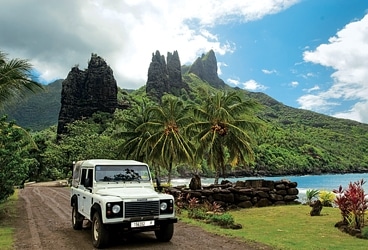From The Edge
Everything in me shudders to a hush as I wade out into the Fakarava lagoon. My heart goes still. My blood. My thoughts. I traveled alone across Tahiti , from Bora-Bora to Moorea to Fakarava, working my way toward the edge. I had hardly slept the past few nights. When I did, I dreamed In the quiet village of Anaho, craggy citadels overlook a bayside marae, or temple, on the town's main road. Opposite: The peace of Tahiti is found in traditional bungalows at Maurii Pension, in wooden unus and in the people. of a giant sea turtle carrying my father, who passed away just before I left on this trip. He talked to me in a voice I couldn't understand. When I awoke in that void between sleep and sunlight, the thousand things I never said to him came rushing in. He had called me the day before he died. Left a message. That was the last of his voice I would hear. Now I'm trying to fi ght back these memories; I have an article to write, a job to do: to explore the fringes of this South Pacific paradise. But what follows me everywhere are the blank final pages of the story between my father and me.
For years, Tahiti has inspired me, grounded me, romanced me, sent me on wild adventures and fascinated me. It's a place that rattles my soul with its beauty and lets me hear the silence. Somehow in the chaos of life — soccer games, kids, buzzing Blackberry, meetings — I had lost the time to mourn my father. So here I am, immersed in the most beautiful water on the planet. I can see for miles across the silver blue plain of the Pacific. I watch storms, one by one, march toward me. Most never quite reach these atolls that make up the slim landfalls of Fakarava. But the ones that do rush over my head in a whoosh of percussive water drops. I stand in the lagoon and let them pelt me.
Then comes the stillness. In the quiet twilight, I close my eyes and slip under the water.
I'm the only person on the only road on Fakarava, riding a scooter that's approaching 40 kilometers an hour. The world seems to flash by. I feel like I would take off if I had wings. Colors flash past. Pink and red and purple bougainvillea, wild and sensual hibiscus, yellow frangipani trees, flame trees, lipstick-red torch ginger, all accompanied by the scent of tiare and the sea. I need to slow down for fear I will outpace the island. On Fakarava, which sits 2 feet above sea level in most places, there is almost no line to differentiate water from land and from sky. I stop to watch local kids jump off a boat dock into a lagoon. They look all of 5 years old, and this water is their playground. Their laughter resonates as they leap in, swim to shore and jump again. It's a simple game. From where they play, their genuine joy ripples out to me.
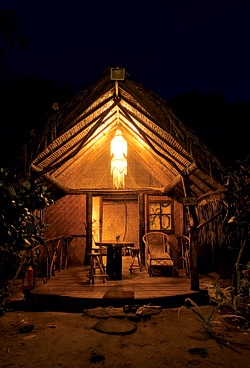
I stop at the boulangerie in the village of Rotoava and order lunch in my best mix of French and English. Frenglish. I pick up pain au raisin and une croque monsieur sandwich. Not many people here speak English. "ia orana," I say, throwing in a Tahitian greeting to the French expat owner.
He asks me where I'm from. I tell him Florida. He stares at me, conjuring Florida or even the United States from a distant memory that has gone unneeded and untended in this corner of the world. Then he nods his head, as if, yes, he does remember such a place.
"Avez-vous visité les fermes de perle?" he asks.
No, I haven't visited the pearl farms. He says I must visit the Pearl Guest House Havaiki on Fakarava. There you can select your own pearl oyster and wish for the good luck that you will open the shell and see a beauty risen from the deep. He says I could keep the pearl. I think of the possibility.
He pats me on the back, looking concerned. "Pourquoi paraissez-vous si triste?" he asks. Why do I look so sad? I don't know. After a moment, he speaks rapidly in French. I ask him to slow down, so he speaks to me slowly, seeming to relish the feel of these words as each slips from his mouth: "Je ne voudrais être nullepart d'autre dans le monde." I would not want to be anywhere else in the world.
We both look out at the lagoon and the big casuarina trees and red-trunked coconut palm trees that line the shore. The blues of the lagoon shimmer in the faint touch of the breeze.
"C'est marvelleaux," I murmur, but in my head I repeat his words. Why do I look so sad?
"Une vie heureux," he says, looking out with me. A happy life. I understand that.
On the way back to where I'm staying, LeMaitai Dream Fakarava, I speak out loud as I ride the scooter, like a whispered enchantment — and just because it's so much fun to hear it come out of my mouth: "Fakarava. Fakarava." It makes me smile.
In Rotoava at the open-air, sand-floor snack teanuanua the next afternoon, I take my lunch sitting on a stool literally in the lagoon, under an umbrella. Life has slowed for me, though the dreams keep me awake. I feel the lines that connect me to the world I normally inhabit unraveling. Small stingrays wing by my feet like a passing of magic carpets. Reef fish stop by. Saddle butterflyfish, surgeonfish, Polynesian wrasse and others, hoping I will be careless with my mahimahi plat du jour. Pearl oyster shells are strung between posts. After lunch, I wander down the shore to Havaiki to pick my own pearl from the sea.
At the Havaiki Pearl Farm, I join a group that includes a French family from Papeete, on the main island of Tahiti , and two other French couples. We walk to the end of the dock, jump in and swim out to where the pearls are. I dive down to pick out a string, and Matthais Teihotaaia, our guide, carries it back to the dock to open. As Matthais pries each oyster open, he explains the process of pearl cultivation to us. Each pearl must be first seeded then pried from the oyster's gonads. We all gather around to see a circus of pearls: baroque, ronde, teardrop, black and yellow and even green ones. We gasp and cheer, and I lean in close to get a better look at what the Tahitian god of pearls and the firmament, Oro, has bestowed upon me. They are all lovely and each unique, in that we have chosen them and they us.
I choose a second pearl oyster. I don't yet know why. Matthais opens it. Everyone sighs. The pearl is round and black and imbued with something ineffable. I turn it over and over in my hand, then put it in my pocket.
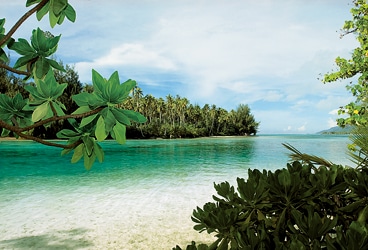
I don't sleep again that night, not until my early morning flight to my next stop, Huahine. As I dream, the turtle appears again, this time swimming away. On its back is not my father, but his spirit. And the turtle is not flesh, but an etching, like a tattoo. My dad never had a connection to Tahiti, yet here he is. I see his uniform, his bronze star, his chest of medals. The morning before he died, I felt a hand grab my shoulder. I feel it again now. I try to grab it this time. I need his leadership, his guidance; he was my mentor. Our family is adrift. I wake up weeping.
When we touch down, I step from the plane into golden light. The lagoon here on Huahine looks radiant. I feel like I'm awake within a dream.
Soon I'm standing knee-deep in a stream in the small village of Faie. My guide, Firmin, leans in next to me with a tin of mackeral while all around my feet and legs slither large and sacred blue-eyed eels. They lift themselves from the water to get to the food, and soon the water writhes with eels that look like muppets. Their translucent eyes are hypnotic. These eels are said to purify the waters.
Firmin tells me a story of the first eel that ventured across the mountains from a pool in Arue on Tahiti. When it arrived at the river, realizing it was alone, the eel courted and married (and no doubt splashed about with a bit) a maiden from a local village of Mataiea. The local people are supposed to be the descendents of this odd union. It's dizzying the legends that filter through this island's lush hillsides and breathtaking lagoons. Firmin seems happy to overwhelm me with them.
But it's not until he tells me of the Pu Fenua custom that I feel I've slipped past the veneer and discovered some- thing truly tapu, sacred. When a child is born on Huahine, tradition states that you bury the placenta and plant a tree there. "As the tree goes, so goes the life," Firmin tells me. "There is vast meaning in the tree for our families. You must take care of the tree as if your life depended upon it." He tells me that if the tree fruits, eating that fruit is like eating a part of the person, which, he says, "pourrait être bon ou mauvais." Translating, he says, "It could be good or bad to eat. I don't know. But most people don't want to eat my mangoes!" He laughs hard.
Firmin soon takes me to one of the most important marae, or sacred temples, on the island. More than 280 survive on Huahine and "many more remain hidden in the jungle," he says. Each new one begins with a stone from an existing marae.
This temple is on the Road of the Wind, where the northwest wind is said to have welcomed the first visitors here. It's studded with wooden poles called unus carved with stories of the messengers of the gods, of the tiis and the spirits, of travel, tapu and the turtle. I so much want to send a message to my dad. I try to imagine what I would say.
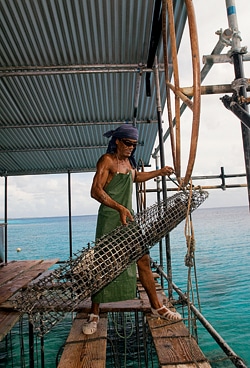
Where the river enters Lake Fauna Nui, we see fish traps that have been in use for hundreds of years. We stop at a high point to simply watch the sea. The most striking thing about Huahine for me is the mix of blues and greens. The Windex colored lagoon rivals any in French Polynesia and the thick, tropical forest and steep hillsides seem every bit as sauvage as they were when the island was first settled. We watch for a while, not speaking. Outriggers pass. Sailboats. Fishermen. And on the horizon we can see the cloud-crowned islands of Raiatea and Tahaa rise from a blue earth. When we continue on, Firmin tells me there are places on Hauhine that no one has ever seen. I believe him. As night falls, I ask him what the most sacred place on the island is.
"The most sacred is far away," Firmin tells me. "It is believing what your eyes don't see."
Long past midnight, I step from my room at Te Tiare Resort and slip, in what has become a nightly ritual, into the cool lagoon water. The resort has no roads and is only reachable by water taxi, so the quiet is exceptional. I sub- merge to my shoulders and become motionless until the moana, the ocean, settles around me. Looking down, my eyes reflect back from a polished pewter surface, like a gaze from deep inside myself. I lay back and float. For the first time since his death, I can hear my father's voice in my head. It has come, po fanua, born of the Tahitian night on an island where life resonates in traditions, in the unseen and in stories that reach back to the beginning of time. I listen to his voice deep into the night.
My father taught me one thing well: that life must be lived. And he loved great warriors and men of honor; they understood the need to do rather than wish because they knew that every moment meant something. He would have appreciated my next Tahitian destination: Nuku Hiva. It's known as Henua Enata, the Land of Men. It's in the Marquesas, 1,200 kilometers from Papeete. The island has no barrier reef, nothing to protect it from the onslaught of the Pacific. It's exposed. Ancient. Primal. Honest. A strange light sits over Nuku Hiva. Silky, misty clouds seem to appear and disappear at will. Steep green slopes rush from the sea to the sky as valleys settle deep within the folds.
"Place has power, name has power," Jean-Pierre, my guide, tells me without explanation almost as soon as he picks me up at the Keikahanui Pearl Lodge. Jean-Pierre's family is from the Taipivai Valley, one of the most beautiful places on earth. The valley, once inhabited by warriors and cannibals, protected a young Herman Melville after he jumped ship and hid out here. Right at this moment, I feel that same urge.
As we pass into the valley, horses quietly graze on the side of the road. Around every bend we encounter natural green cathedrals with buttresses and sharp spires and imposing cliffs, pinnacles and altars. White seabirds soar in front of green cliff faces while waterfalls drop from only the most picturesque of locations. The road winds down the slopes to Anaho , a small village on a compact bay surrounded on all sides by sharp mountains and ridges. It's raining, so we take an early lunch of crevettes au curry avec manioc et breadfruit in a restaurant crowded by flowering hibiscus. Then we venture up the hill to explore three huge sacred marae covered with stone tikis.
The sites spread over acres of jungle. At the fi rst site, Kamuihei, a huge, grandfatherly banyon tree dominates as much as the old structures. The other two, Tahakia and Hikokua, combine to make this the largest such site in Polynesia. Massive stone compounds have lifted their heads from the jungled slopes. In a place of warriors and honor, a culture's roots cannot be denied, it seems, and on Nuku Hiva they are rising and shouting from the sacred rocks.
Just after sunrise the next morning, Jean-Pierre and I hike up the Hakaui Valley to the base of the 1,148-foot Vaipo Waterfall . We follow a path that passes through forests of kapok and banyon that seem untouched by time. We spot a rare Nuku Hiva imperial pigeon, the Marquesas lorikeet and fruit doves. As the path continues, the walls of the valley close in on us until we go through a narrow ravine that opens into fields of vividly green ferns. At the base of the waterfall on either side, walls rise up 1,000 feet above us. We rest and lunch on fromage et baguettes and feed the eel that resides in the pool.
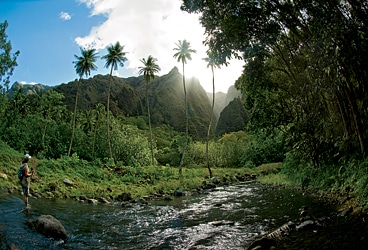
Separated from Jean-Pierre by my slow pace, I hike alone on the way back. It's as if I'm deserted on this unspoiled island. It's spellbinding — and it's hot. I'm drained from the physical activity. I pick fruit as I go, sucking the juice from pamplemouse. I stand in the middle of the river, looking up, cooling off, surrounded by a view I can barely wrap my head around. My thoughts reverberate around this craggy and fierce natural wonderland until they come back to me like bullets. Place has power, name has power. I sense my father again.
Back in town I meet up with a local tattoo artist named Jean-Yves. He's young, but he knows the stories kept in the symbols that have adorned the skin of Marquesans since the beginning of their history. Jean-Yves and people like him are a potent symbol of the cultural renaissance of the Land of Men. And men here were once considered the link between heaven and earth. The stories in the tattoos helped men unify the two. He tells me that tattoos should be done with intuition, to express both the tapu and the personal. And never copied. The artist should defi ne the tattoo based upon his interpretations. We end up talking of honor, loyalty and of the power of family and tradition. And we speak of les enfants, our children, and why they need to know their stories.
Finally, I tell him about my dreams in Tahiti, of the turtle, the moana and the voice of my father. He pauses. I can see in his eyes he understands. I have come to Tahiti to heal. For the next 90 minutes, starting with just two circles and instinct, he unites my past and future on my heart.
The pain of the tattoo is the beginning for me. In that feral silence of sorrow, I finally start to mend, not just grieve. On my chest, my father's mana, his spirit, now rides on the back of a turtle, protected forever by tikis and wrapped in a sacred circle of symbols that crystallizes my connection to myself and my father and family. This island allowed my father to reach me, to hold me in his heart. My breath, I know, is his breath. His memory, his voice, his guidance rush back.
Later, as I look at myself in the mirror in my room, a tear drops and mixes with the blood and ink on my chest. Tahiti, my long affair with these islands — an affair that has become complex, enlightening, revealing and endlessly captivating — has now become a place to mend my spirit.
I find the second pearl from Fakarava in my pocket. I hold it again in my hand. It feels warm now. Like a thousand happy memories.
See more articles about Tahiti.
